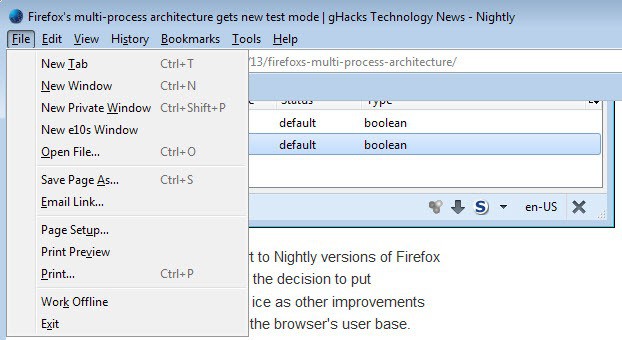Firefox's Multi-process architecture becomes a priority finally

If you ask Chrome users why they are using Google's web browser and not Firefox, you will often hear that Chrome is faster, leaner or slimmer. Tech-savvy users on the other hand may name Chrome's multi-process architecture and sandboxing as the number one reason why they are using Chrome and not Firefox.
Mozilla started to work on a multi-process architecture for Firefox back in 2009 but put it on a backburner later on to implement other changes that promised to yield a higher return in terms of resource usage and benefits.
Electrolysis (E10), that is the codename for the project, has gained some traction recently after it was brought back from the dead 13 months ago.
The project will also pave the way for sandboxing in the browser, even though it is not a part of the project itself. This means that Firefox may not support sandboxing when Electrolysis lands in the stable version, but that it is likely that it will eventually because of it.
A development version has been part of Firefox's cutting edge channel Nightly for several months now. You had to flip a configuration switch previously to enable the functionality in the browser. This changed with the release of Firefox 30 when Mozilla integrated the option to launch a new Electrolysis window in the browser's File menu.
Since the menu is not displayed by default anymore, you may need to tap on Alt to display the menu bar in the browser.
A new post by program manager Chris Peterson confirms that Mozilla seems to have made e10s a development priority as new members have been added to the team recently.
According to the post, several Firefox Metro engineers, a new engineering manager, a Google Summer of Code student, and a gfx contractor have been added to the project team recently.
Since development stopped on the Metro version of Firefox for Windows 8 some time ago, resources became available that the project now benefits from.
A member increase underlines the importance of the project for Mozilla. The team has not released information yet on a projected stable release date, and it is unlikely that this is going to happen anytime soon. What is clear though that development will accelerate thanks to the addition.
The core bugs are 516752, 997456 and 997462 highlight many dependencies and blockers that the team needs to address before e10s will be released. (via Sören)





















Nicely written article, Martin :)
Multi-process is the main reason why I use Chrome. It open very very fast and can have a lot of video pages without any problem. When I use firefox and try to open 2 or more pages with videos it often crash or is really slow.
Congrats Firefox!
Also in the dropdown menu is an e10s button you can drag to the navbar.
If I ask a Chrome user why they’re using Chrome, it’s usually because “one day the computer changed it by itself”.
On a different note, does this mean Firefox will be twenty different threads in Task Manager, and I’ll have to kill them all separately one by one? I don’t want that :-/
If its anything like chrome, you will have a tree like structure – a core process with a heap of children – and you can select the topmost process and “Kill Process Tree” – I use Process Explorer from System Internals ( http://technet.microsoft.com/en-us/sysinternals/bb896653 )
“The team has not released information yet on a projected stable release date, and it is unlikely that this is going to happen anytime soon.”
A distant release date is most unfortunate. Currently, a Firefox tab that uses a great deal of resources tends to slow down processing in all of the other tabs. I was hoping that the new multi-process architecture would be released soon in order to potentially avoid this problematic situation.
Chrome’s multi-process design is one reason why I do NOT use Chrome. It uses way too much memory. hopefully Mozilla can devise a more efficient way to make use of multi-process design.
The reduced memory efficiency of a single process becomes a moot point after running FF for several days. The lack of proper garbage collection means that memory use piles up as the browser is used. Closing tabs and windows does not aliviate the problem. You have to shut down the browser entirely to free that memory. It’s a terrible architecture.
Agreed. When all you do is hibernate and resume, Firefox becomes worse and worse. Anonymous who replied to you commits the standard business fallacy of blaming behaviour, when actually the technology should just be able to cope with any behaviour.
You’re complaining about memory from leaving your computer on for several days with Firefox open? Are you serious?
I was going to post the same exact reason I don’t use Chrome. It’s memory footprint is about 3 times that of Firefox’s memory footprint. Hopefully Martin is correct, and Firefox’s won’t skyrocket up to Chrome’s amount.
The Mozilla implementation will be memory efficient.
I hardly believe it.
They have only a few Mb increase while disconnecting UI of the content, but when they’ll separate tabs it’ll obviously go higher, even if they try to mitigate it.
I’ll believe it when I see it myself.
What do that mean exactly ?
Of course if it uses the *same* amount of memory it will be efficient. But I fear it will use a good bunch more. :/
If you have any link which provide detailed info on that matter, could you share it ?
It will only use a couple of megabytes more than a single-process Firefox: http://billmccloskey.wordpress.com/2013/12/05/multiprocess-firefox/#when